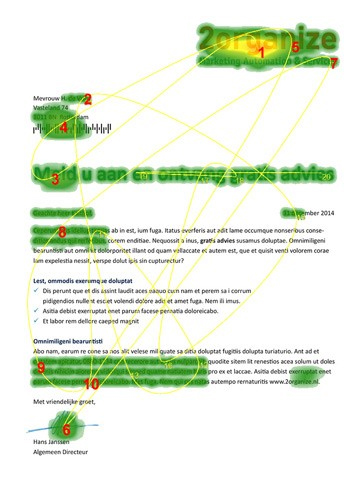The graphic above is what’s called a “heat map.” It tracks where reader’s eyes looked as they read this piece of direct mail fundraising. It also tracks the order in which the reader looked at each area.
There’s a LOT this can teach an organization about how to succeed in fundraising through the mail and email…
The “Heat Map” Lessons
Not all heat maps look exactly the same. But they generally look like this one, and they all teach the same lessons:
- Most donors don’t read the whole thing
- Most donors don’t read your letters in order – they “skip around”
- Large type, and type in the upper right corner, will get more attention
- They tend to focus on the beginning and the end
- They are more likely to read words on the left side of the page than on the right side of the page
Many people at nonprofits find this news distressing.
I find it powerful.
Because once you know how direct mail works, you can use it to raise more money for your cause than you’re currently raising.
The Big Takeaway
So what do you do with this information?
Write your next appeal with the knowledge that you’re writing two letters in one:
- One complete fundraising appeal needs to fit in the green areas (more or less). Because most people will scan your letter and decide whether to give a gift – or not – only by looking at the green areas. Your ‘letter in the green areas’ needs to contain everything a donor needs to know to decide whether to give you a gift today.
- And the entire letter, from start to finish, needs to make sense for the minority of people who will read the whole letter and decide whether to give a gift or not.
The big idea here is that even though you only write one letter, it’s written and designed to work for BOTH groups of your donors.
The most effective direct mail appeals are written and designed to get the main message across in both the green areas and in the rest of the letter.
To do this well requires a particular style of writing. It’s a style that can be learned.
The tricky part – in my opinion – is to get people who don’t prefer that style of writing to see the reason for it and the benefits of it.
What To Do Now
So here’s the question: are your organization’s letters written and designed to get the main message across to both groups?
If your organization is writing and designing only for donors who read the whole thing, you can be raising a LOT more money.
If that’s you, here are the steps I’d follow. Make sure that the “powers that be” at your organization know about:
- Heat maps and the lessons they teach
- How you have two groups of readers
- How it’s more inclusive to write letters that work for both groups
- And how writing for both groups will raise you more money because you’re multiplying how many people receive your message.
In the next post, I’ll talk about how to write an appeal that works for both groups.
If this were a normal post, I’d go ahead right now and share how to write this type of appeal. But I find that it’s not the “tactic” of writing for both groups that holds organizations back from doing it.
What holds them back is either the belief that it doesn’t apply to their organization, or that they don’t like that style of fundraising letter (or email).
So let’s just sit for a couple of days with the idea that there’s a style of fundraising appeal that’s written only for people who will read the whole thing. And if that’s the style your organization is using, in my experience your message is not reaching a very large percentage of your donors, and you’re not raising as much money (and doing as much good) as you could be.
Steven Screen is Co-Founder of The Better Fundraising Company and lead author of its blog. With over 30 years' fundraising experience, he gets energized by helping organizations understand how they can raise more money. He’s a second-generation fundraiser, a past winner of the Direct Mail Package of the Year, and data-driven.









11 comments on “Lessons from a “Heat Map””